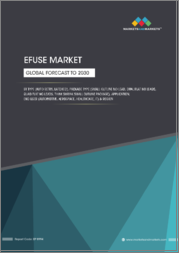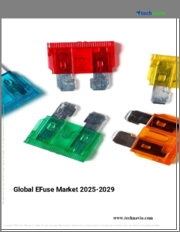
|
시장보고서
상품코드
1748845
세계의 전자퓨즈(eFuse) 시장 : 산업규모, 점유율, 동향, 기회, 예측, 제품 유형별, 용도별, 지역별, 경쟁별(2020-2030년)eFuse Market - Global Industry Size, Share, Trends, Opportunity, and Forecast, Segmented By Product Type, By Application, By Region & Competition, 2020-2030F |
||||||
세계의 전자퓨즈 시장은 2024년에는 7억 6,442만 달러로 평가되었고, 2030년에는 10억 4,251만 달러에 이를 것으로 예측되며, 예측 기간 중 CAGR은 5.15%를 나타낼 전망입니다.
전자퓨즈(eFuse)는 기존의 기계식 퓨즈를 대체하는 고체 상태 장치로, 자동 재시도, 프로그래밍 가능한 전류 임계값, 통합 진단 기능 등 고급 기능을 제공합니다. 이러한 기능은 과전압, 과전류, 단락, 열적 사건에 대한 우수한 보호 기능을 제공하여 소비자 전자제품, 자동차, 통신, 산업 자동화 등 다양한 분야에서 이상적인 솔루션으로 자리매김하고 있습니다. 전자 기기의 소형화 및 복잡성 증가와 고성능 및 신뢰성 있는 보호 장치의 필요성이 전자퓨즈 채택을 촉진하고 있습니다. 아시아태평양 지역은 강력한 전자 제조 기반을 바탕으로 시장을 주도하고 있으며, 북미와 유럽은 기술 혁신과 규제 요구사항에 힘입어 성장하고 있습니다. 전기 차량, 5G 인프라, 소형 스마트 기기의 급증은 프로그래밍 가능한 회로 보호 솔루션인 전자퓨즈 대한 의존도를 더욱 높이고 있습니다.
| 시장 개요 | |
|---|---|
| 예측 기간 | 2026-2030년 |
| 시장 규모(2024년) | 7억 6,442만 달러 |
| 시장 규모(2030년) | 10억 4,251만 달러 |
| CAGR(2025-2030년) | 5.15% |
| 급성장 부문 | 통합형 전자퓨즈 |
| 최대 시장 | 북미 |
시장 성장 촉진요인
고급 가전제품에 대한 수요 증가
주요 시장 과제
높은 초기 비용 및 통합 복잡성
주요 시장 동향
전력 관리 IC에 프로그래밍 가능성과 텔레메트리 통합
목차
제1장 개요
제2장 조사 방법
제3장 주요 요약
제4장 고객의 목소리
제5장 세계의 전자퓨즈 시장 전망
- 시장 규모와 예측
- 금액별
- 시장 점유율 및 예측
- 제품 유형별(이산 전자퓨즈, 통합형 전자퓨즈)
- 용도별(자동차, 가전, 통신, 의료, 기타)
- 지역별(북미, 유럽, 남미, 중동 및 아프리카, 아시아태평양)
- 기업별(2024년)
- 시장 맵
제6장 북미의 전자퓨즈 시장 전망
- 시장 규모와 예측
- 시장 점유율 및 예측
- 북미 : 국가별 분석
- 미국
- 캐나다
- 멕시코
제7장 유럽의 전자퓨즈 시장 전망
- 시장 규모와 예측
- 시장 점유율 및 예측
- 유럽 : 국가별 분석
- 독일
- 프랑스
- 영국
- 이탈리아
- 스페인
제8장 아시아태평양의 전자퓨즈 시장 전망
- 시장 규모와 예측
- 시장 점유율 및 예측
- 아시아태평양 : 국가별 분석
- 중국
- 인도
- 일본
- 한국
- 호주
제9장 중동 및 아프리카의 전자퓨즈 시장 전망
- 시장 규모와 예측
- 시장 점유율 및 예측
- 중동 및 아프리카 : 국가별 분석
- 사우디아라비아
- 아랍에미리트(UAE)
- 남아프리카
제10장 남미의 전자퓨즈 시장 전망
- 시장 규모와 예측
- 시장 점유율 및 예측
- 남미 : 국가별 분석
- 브라질
- 콜롬비아
- 아르헨티나
제11장 시장 역학
- 성장 촉진요인
- 과제
제12장 시장 동향과 발전
- 합병과 인수
- 제품 출시
- 최근 동향
제13장 기업 프로파일
- Texas Instruments Incorporated
- Analog Devices, Inc.
- STMicroelectronics
- ON Semiconductor Corporation
- NXP Semiconductors NV
- Renesas Electronics Corporation
- Infineon Technologies AG
- Vicor Corporation
- Broadcom Inc.
- Littelfuse, Inc.
제14장 전략적 제안
제15장 기업 소개 및 면책사항
HBR 25.06.24The Global eFuse Market was valued at USD 764.42 Million in 2024 and is projected to reach USD 1,042.51 Million by 2030, growing at a CAGR of 5.15% during the forecast period. The market is expanding rapidly due to the increasing demand for intelligent, space-efficient circuit protection in modern electronic systems. eFuses, or electronic fuses, are solid-state devices that replace traditional mechanical fuses and offer advanced features such as auto-retry, programmable current thresholds, and integrated diagnostics. These features provide superior protection against overvoltage, overcurrent, short circuits, and thermal events, making them ideal for sectors like consumer electronics, automotive, telecom, and industrial automation. The growing miniaturization and complexity of electronics, coupled with the need for high-performance and reliable protection, are propelling eFuse adoption. Asia Pacific dominates the market due to its robust electronics manufacturing base, while North America and Europe are driven by technological innovation and regulatory requirements. The surge in electric vehicles, 5G infrastructure, and compact smart devices further underscores the growing reliance on programmable circuit protection solutions like eFuses.
| Market Overview | |
|---|---|
| Forecast Period | 2026-2030 |
| Market Size 2024 | USD 764.42 Million |
| Market Size 2030 | USD 1,042.51 Million |
| CAGR 2025-2030 | 5.15% |
| Fastest Growing Segment | Integrated e Fuses |
| Largest Market | North America |
Key Market Drivers
Rising Demand for Advanced Consumer Electronics
The growing popularity of high-performance and compact consumer electronics is a key driver for eFuse adoption. Devices such as smartphones, tablets, wearables, and laptops require intelligent circuit protection that supports miniaturization and high power density. eFuses meet these needs with built-in features like programmable current limits, thermal protection, and auto-retry, ensuring device reliability and safety.
Global shipments of smartphones, wearables, and laptops have surged, with smartphones exceeding 1.39 billion units in 2024 and wearable devices reaching 530 million units. As the average power density in consumer electronics continues to rise, the need for advanced protection solutions becomes more pressing. Traditional fuses lack reset and diagnostic capabilities, while eFuses enable fault detection and self-recovery, reducing field failures and improving end-user experience. Their compact size and smart features make them ideal for modern electronics, driving demand across a range of consumer applications.
Key Market Challenges
High Initial Cost and Integration Complexity
Although eFuses provide advanced protection, their higher cost compared to conventional fuses poses a challenge in cost-sensitive markets. For manufacturers of entry-level consumer devices and low-cost industrial equipment, the price premium of eFuses may not be easily justified.
Additionally, eFuses often require integration with digital control systems and programmable interfaces like I2C or PMBus, increasing design complexity. This complexity necessitates additional engineering expertise and development time, especially for teams unfamiliar with digital circuit protection.
Legacy systems designed for passive fuses may require redesigning PCBs or modifying power architectures to accommodate eFuses. These extra steps, combined with higher costs, can deter adoption, particularly for manufacturers operating on tight margins or those lacking resources for redesign and validation.
Key Market Trends
Integration of Programmability and Telemetry in Power Management ICs
An emerging trend in the eFuse market is the increasing integration of programmability and telemetry features in power management systems. Modern eFuses now allow configuration of critical parameters such as current limits, voltage thresholds, and delay timings via digital interfaces like I2C or PMBus.
These programmable features are complemented by real-time telemetry, enabling system-level monitoring of voltage, current, temperature, and fault events. This capability enhances fault diagnosis and predictive maintenance in data centers, telecom networks, and industrial systems where uptime is crucial.
As digital infrastructure grows and AI-based monitoring becomes more prevalent, programmable eFuses are being adopted for applications that require proactive, adaptive protection mechanisms. These intelligent features are transforming eFuses from simple protection devices to vital components in smart power management ecosystems.
Key Market Players
- Texas Instruments Incorporated
- Analog Devices, Inc.
- STMicroelectronics
- ON Semiconductor Corporation
- NXP Semiconductors N.V.
- Renesas Electronics Corporation
- Infineon Technologies AG
- Vicor Corporation
- Broadcom Inc.
- Littelfuse, Inc.
Report Scope:
In this report, the Global EFuse Market has been segmented into the following categories, in addition to the industry trends which have also been detailed below:
EFuse Market, By Product Type:
- Discrete eFuses
- Integrated eFuses
EFuse Market, By Application:
- Automotive
- Consumer Electronics
- Telecommunications
- Healthcare
- Others
EFuse Market, By Region:
- North America
- United States
- Canada
- Mexico
- Europe
- Germany
- France
- United Kingdom
- Italy
- Spain
- South America
- Brazil
- Argentina
- Colombia
- Asia-Pacific
- China
- India
- Japan
- South Korea
- Australia
- Middle East & Africa
- Saudi Arabia
- UAE
- South Africa
Competitive Landscape
Company Profiles: Detailed analysis of the major companies present in the Global EFuse Market.
Available Customizations:
Global EFuse Market report with the given market data, TechSci Research offers customizations according to a company's specific needs. The following customization options are available for the report:
Company Information
- Detailed analysis and profiling of additional market players (up to five).
Table of Contents
1. Product Overview
- 1.1. Market Definition
- 1.2. Scope of the Market
- 1.2.1. Markets Covered
- 1.2.2. Years Considered for Study
- 1.2.3. Key Market Segmentations
2. Research Methodology
- 2.1. Objective of the Study
- 2.2. Baseline Methodology
- 2.3. Key Industry Partners
- 2.4. Major Association and Secondary Sources
- 2.5. Forecasting Methodology
- 2.6. Data Triangulation & Validation
- 2.7. Assumptions and Limitations
3. Executive Summary
- 3.1. Overview of the Market
- 3.2. Overview of Key Market Segmentations
- 3.3. Overview of Key Market Players
- 3.4. Overview of Key Regions/Countries
- 3.5. Overview of Market Drivers, Challenges, and Trends
4. Voice of Customer
5. Global EFuse Market Outlook
- 5.1. Market Size & Forecast
- 5.1.1. By Value
- 5.2. Market Share & Forecast
- 5.2.1. By Product Type (Discrete eFuses, Integrated eFuses)
- 5.2.2. By Application (Automotive, Consumer Electronics, Telecommunications, Healthcare, Others)
- 5.2.3. By Region (North America, Europe, South America, Middle East & Africa, Asia Pacific)
- 5.3. By Company (2024)
- 5.4. Market Map
6. North America EFuse Market Outlook
- 6.1. Market Size & Forecast
- 6.1.1. By Value
- 6.2. Market Share & Forecast
- 6.2.1. By Product Type
- 6.2.2. By Application
- 6.2.3. By Country
- 6.3. North America: Country Analysis
- 6.3.1. United States EFuse Market Outlook
- 6.3.1.1. Market Size & Forecast
- 6.3.1.1.1. By Value
- 6.3.1.2. Market Share & Forecast
- 6.3.1.2.1. By Product Type
- 6.3.1.2.2. By Application
- 6.3.1.1. Market Size & Forecast
- 6.3.2. Canada EFuse Market Outlook
- 6.3.2.1. Market Size & Forecast
- 6.3.2.1.1. By Value
- 6.3.2.2. Market Share & Forecast
- 6.3.2.2.1. By Product Type
- 6.3.2.2.2. By Application
- 6.3.2.1. Market Size & Forecast
- 6.3.3. Mexico EFuse Market Outlook
- 6.3.3.1. Market Size & Forecast
- 6.3.3.1.1. By Value
- 6.3.3.2. Market Share & Forecast
- 6.3.3.2.1. By Product Type
- 6.3.3.2.2. By Application
- 6.3.3.1. Market Size & Forecast
- 6.3.1. United States EFuse Market Outlook
7. Europe EFuse Market Outlook
- 7.1. Market Size & Forecast
- 7.1.1. By Value
- 7.2. Market Share & Forecast
- 7.2.1. By Product Type
- 7.2.2. By Application
- 7.2.3. By Country
- 7.3. Europe: Country Analysis
- 7.3.1. Germany EFuse Market Outlook
- 7.3.1.1. Market Size & Forecast
- 7.3.1.1.1. By Value
- 7.3.1.2. Market Share & Forecast
- 7.3.1.2.1. By Product Type
- 7.3.1.2.2. By Application
- 7.3.1.1. Market Size & Forecast
- 7.3.2. France EFuse Market Outlook
- 7.3.2.1. Market Size & Forecast
- 7.3.2.1.1. By Value
- 7.3.2.2. Market Share & Forecast
- 7.3.2.2.1. By Product Type
- 7.3.2.2.2. By Application
- 7.3.2.1. Market Size & Forecast
- 7.3.3. United Kingdom EFuse Market Outlook
- 7.3.3.1. Market Size & Forecast
- 7.3.3.1.1. By Value
- 7.3.3.2. Market Share & Forecast
- 7.3.3.2.1. By Product Type
- 7.3.3.2.2. By Application
- 7.3.3.1. Market Size & Forecast
- 7.3.4. Italy EFuse Market Outlook
- 7.3.4.1. Market Size & Forecast
- 7.3.4.1.1. By Value
- 7.3.4.2. Market Share & Forecast
- 7.3.4.2.1. By Product Type
- 7.3.4.2.2. By Application
- 7.3.4.1. Market Size & Forecast
- 7.3.5. Spain EFuse Market Outlook
- 7.3.5.1. Market Size & Forecast
- 7.3.5.1.1. By Value
- 7.3.5.2. Market Share & Forecast
- 7.3.5.2.1. By Product Type
- 7.3.5.2.2. By Application
- 7.3.5.1. Market Size & Forecast
- 7.3.1. Germany EFuse Market Outlook
8. Asia Pacific EFuse Market Outlook
- 8.1. Market Size & Forecast
- 8.1.1. By Value
- 8.2. Market Share & Forecast
- 8.2.1. By Product Type
- 8.2.2. By Application
- 8.2.3. By Country
- 8.3. Asia Pacific: Country Analysis
- 8.3.1. China EFuse Market Outlook
- 8.3.1.1. Market Size & Forecast
- 8.3.1.1.1. By Value
- 8.3.1.2. Market Share & Forecast
- 8.3.1.2.1. By Product Type
- 8.3.1.2.2. By Application
- 8.3.1.1. Market Size & Forecast
- 8.3.2. India EFuse Market Outlook
- 8.3.2.1. Market Size & Forecast
- 8.3.2.1.1. By Value
- 8.3.2.2. Market Share & Forecast
- 8.3.2.2.1. By Product Type
- 8.3.2.2.2. By Application
- 8.3.2.1. Market Size & Forecast
- 8.3.3. Japan EFuse Market Outlook
- 8.3.3.1. Market Size & Forecast
- 8.3.3.1.1. By Value
- 8.3.3.2. Market Share & Forecast
- 8.3.3.2.1. By Product Type
- 8.3.3.2.2. By Application
- 8.3.3.1. Market Size & Forecast
- 8.3.4. South Korea EFuse Market Outlook
- 8.3.4.1. Market Size & Forecast
- 8.3.4.1.1. By Value
- 8.3.4.2. Market Share & Forecast
- 8.3.4.2.1. By Product Type
- 8.3.4.2.2. By Application
- 8.3.4.1. Market Size & Forecast
- 8.3.5. Australia EFuse Market Outlook
- 8.3.5.1. Market Size & Forecast
- 8.3.5.1.1. By Value
- 8.3.5.2. Market Share & Forecast
- 8.3.5.2.1. By Product Type
- 8.3.5.2.2. By Application
- 8.3.5.1. Market Size & Forecast
- 8.3.1. China EFuse Market Outlook
9. Middle East & Africa EFuse Market Outlook
- 9.1. Market Size & Forecast
- 9.1.1. By Value
- 9.2. Market Share & Forecast
- 9.2.1. By Product Type
- 9.2.2. By Application
- 9.2.3. By Country
- 9.3. Middle East & Africa: Country Analysis
- 9.3.1. Saudi Arabia EFuse Market Outlook
- 9.3.1.1. Market Size & Forecast
- 9.3.1.1.1. By Value
- 9.3.1.2. Market Share & Forecast
- 9.3.1.2.1. By Product Type
- 9.3.1.2.2. By Application
- 9.3.1.1. Market Size & Forecast
- 9.3.2. UAE EFuse Market Outlook
- 9.3.2.1. Market Size & Forecast
- 9.3.2.1.1. By Value
- 9.3.2.2. Market Share & Forecast
- 9.3.2.2.1. By Product Type
- 9.3.2.2.2. By Application
- 9.3.2.1. Market Size & Forecast
- 9.3.3. South Africa EFuse Market Outlook
- 9.3.3.1. Market Size & Forecast
- 9.3.3.1.1. By Value
- 9.3.3.2. Market Share & Forecast
- 9.3.3.2.1. By Product Type
- 9.3.3.2.2. By Application
- 9.3.3.1. Market Size & Forecast
- 9.3.1. Saudi Arabia EFuse Market Outlook
10. South America EFuse Market Outlook
- 10.1. Market Size & Forecast
- 10.1.1. By Value
- 10.2. Market Share & Forecast
- 10.2.1. By Product Type
- 10.2.2. By Application
- 10.2.3. By Country
- 10.3. South America: Country Analysis
- 10.3.1. Brazil EFuse Market Outlook
- 10.3.1.1. Market Size & Forecast
- 10.3.1.1.1. By Value
- 10.3.1.2. Market Share & Forecast
- 10.3.1.2.1. By Product Type
- 10.3.1.2.2. By Application
- 10.3.1.1. Market Size & Forecast
- 10.3.2. Colombia EFuse Market Outlook
- 10.3.2.1. Market Size & Forecast
- 10.3.2.1.1. By Value
- 10.3.2.2. Market Share & Forecast
- 10.3.2.2.1. By Product Type
- 10.3.2.2.2. By Application
- 10.3.2.1. Market Size & Forecast
- 10.3.3. Argentina EFuse Market Outlook
- 10.3.3.1. Market Size & Forecast
- 10.3.3.1.1. By Value
- 10.3.3.2. Market Share & Forecast
- 10.3.3.2.1. By Product Type
- 10.3.3.2.2. By Application
- 10.3.3.1. Market Size & Forecast
- 10.3.1. Brazil EFuse Market Outlook
11. Market Dynamics
- 11.1. Drivers
- 11.2. Challenges
12. Market Trends and Developments
- 12.1. Merger & Acquisition (If Any)
- 12.2. Product Launches (If Any)
- 12.3. Recent Developments
13. Company Profiles
- 13.1. Texas Instruments Incorporated
- 13.1.1. Business Overview
- 13.1.2. Key Revenue and Financials
- 13.1.3. Recent Developments
- 13.1.4. Key Personnel
- 13.1.5. Key Product/Services Offered
- 13.2. Analog Devices, Inc.
- 13.3. STMicroelectronics
- 13.4. ON Semiconductor Corporation
- 13.5. NXP Semiconductors N.V.
- 13.6. Renesas Electronics Corporation
- 13.7. Infineon Technologies AG
- 13.8. Vicor Corporation
- 13.9. Broadcom Inc.
- 13.10. Littelfuse, Inc.
14. Strategic Recommendations
15. About Us & Disclaimer
(주말 및 공휴일 제외)


















